Civil Rights Movement: Comparing King and X's Strategies and Legacies
VerifiedAdded on 2022/12/18
|8
|2462
|3
Essay
AI Summary
This analytical essay delves into the civil rights movement, exploring the enduring legacies of Martin Luther King Jr. and Malcolm X and their relevance to contemporary movements like Black Lives Matter and Idle No More. It examines King's philosophy of non-violent resistance, as articulated in his 'Letter from Birmingham Jail,' and his emphasis on proactive engagement and strategic protest. The essay contrasts this with Malcolm X's more radical approach, particularly his advocacy for 'direct action' and black nationalism, as expressed in his 'The Ballot or the Bullet' speech. By comparing and contrasting their approaches, the essay aims to highlight how these historical figures can provide valuable insights for modern movements striving for equality and justice. The essay also addresses the historical context of racial discrimination and oppression, and it examines the strategies that these leaders employed to challenge the dominant power structures of their time.
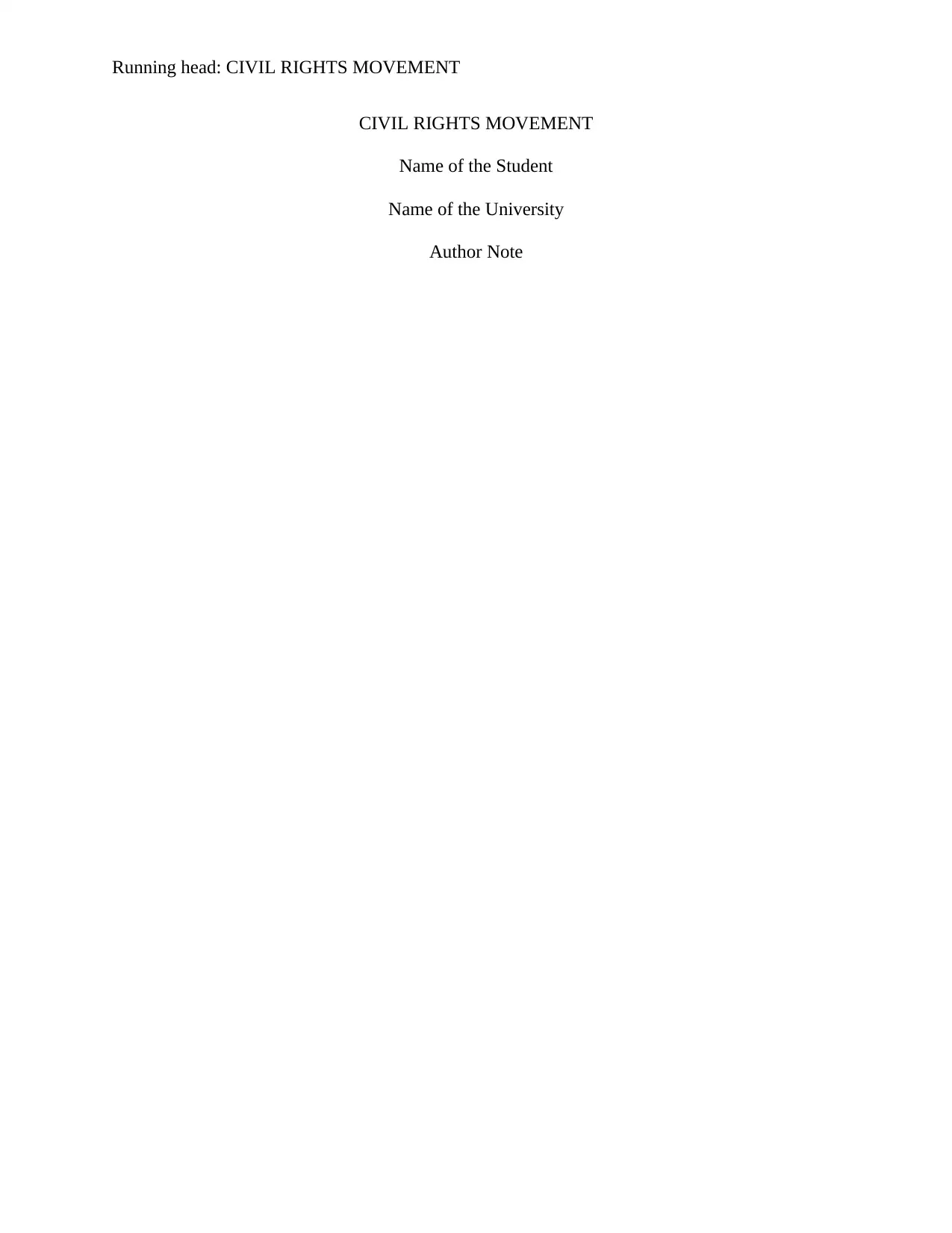
Running head: CIVIL RIGHTS MOVEMENT
CIVIL RIGHTS MOVEMENT
Name of the Student
Name of the University
Author Note
CIVIL RIGHTS MOVEMENT
Name of the Student
Name of the University
Author Note
Paraphrase This Document
Need a fresh take? Get an instant paraphrase of this document with our AI Paraphraser
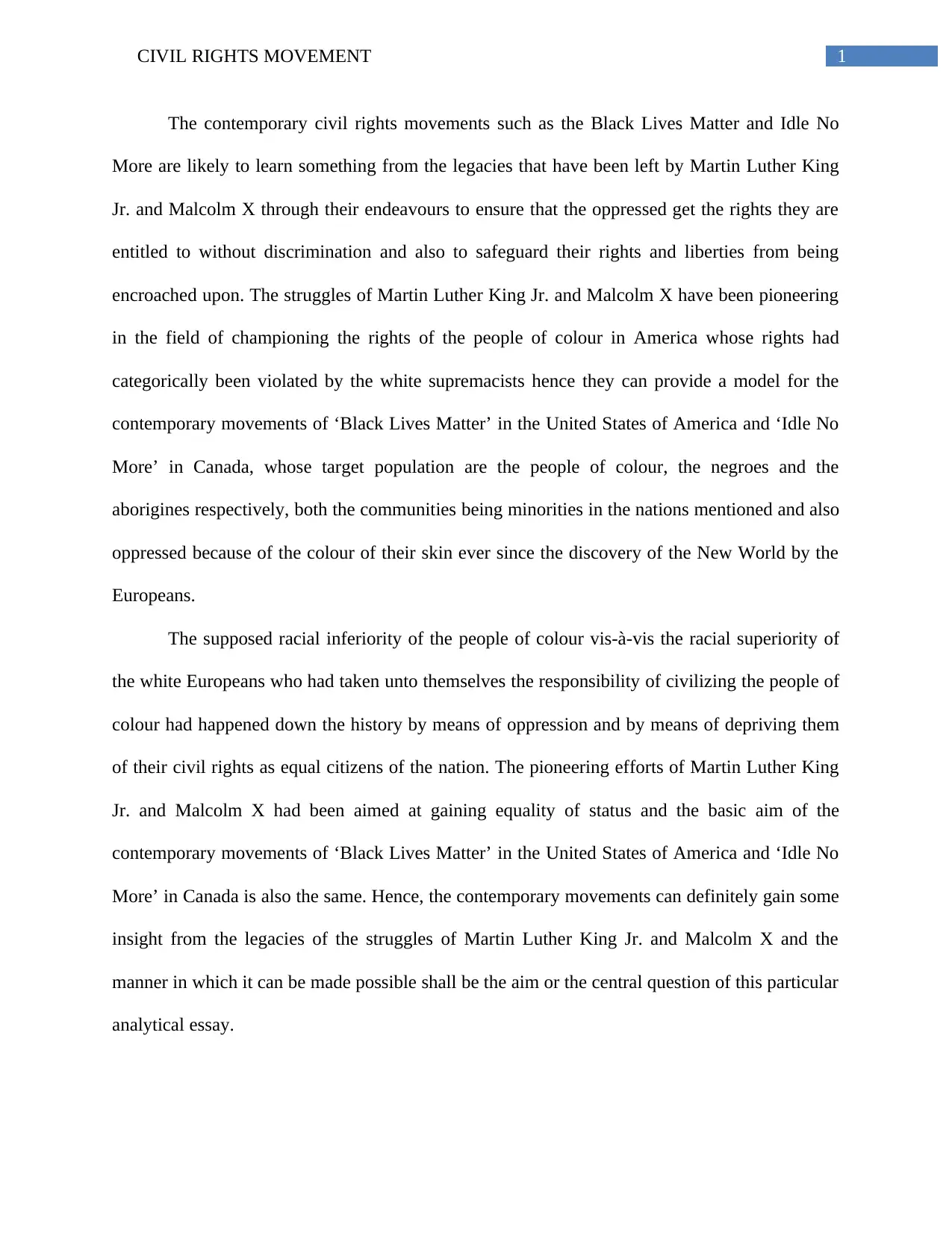
1CIVIL RIGHTS MOVEMENT
The contemporary civil rights movements such as the Black Lives Matter and Idle No
More are likely to learn something from the legacies that have been left by Martin Luther King
Jr. and Malcolm X through their endeavours to ensure that the oppressed get the rights they are
entitled to without discrimination and also to safeguard their rights and liberties from being
encroached upon. The struggles of Martin Luther King Jr. and Malcolm X have been pioneering
in the field of championing the rights of the people of colour in America whose rights had
categorically been violated by the white supremacists hence they can provide a model for the
contemporary movements of ‘Black Lives Matter’ in the United States of America and ‘Idle No
More’ in Canada, whose target population are the people of colour, the negroes and the
aborigines respectively, both the communities being minorities in the nations mentioned and also
oppressed because of the colour of their skin ever since the discovery of the New World by the
Europeans.
The supposed racial inferiority of the people of colour vis-à-vis the racial superiority of
the white Europeans who had taken unto themselves the responsibility of civilizing the people of
colour had happened down the history by means of oppression and by means of depriving them
of their civil rights as equal citizens of the nation. The pioneering efforts of Martin Luther King
Jr. and Malcolm X had been aimed at gaining equality of status and the basic aim of the
contemporary movements of ‘Black Lives Matter’ in the United States of America and ‘Idle No
More’ in Canada is also the same. Hence, the contemporary movements can definitely gain some
insight from the legacies of the struggles of Martin Luther King Jr. and Malcolm X and the
manner in which it can be made possible shall be the aim or the central question of this particular
analytical essay.
The contemporary civil rights movements such as the Black Lives Matter and Idle No
More are likely to learn something from the legacies that have been left by Martin Luther King
Jr. and Malcolm X through their endeavours to ensure that the oppressed get the rights they are
entitled to without discrimination and also to safeguard their rights and liberties from being
encroached upon. The struggles of Martin Luther King Jr. and Malcolm X have been pioneering
in the field of championing the rights of the people of colour in America whose rights had
categorically been violated by the white supremacists hence they can provide a model for the
contemporary movements of ‘Black Lives Matter’ in the United States of America and ‘Idle No
More’ in Canada, whose target population are the people of colour, the negroes and the
aborigines respectively, both the communities being minorities in the nations mentioned and also
oppressed because of the colour of their skin ever since the discovery of the New World by the
Europeans.
The supposed racial inferiority of the people of colour vis-à-vis the racial superiority of
the white Europeans who had taken unto themselves the responsibility of civilizing the people of
colour had happened down the history by means of oppression and by means of depriving them
of their civil rights as equal citizens of the nation. The pioneering efforts of Martin Luther King
Jr. and Malcolm X had been aimed at gaining equality of status and the basic aim of the
contemporary movements of ‘Black Lives Matter’ in the United States of America and ‘Idle No
More’ in Canada is also the same. Hence, the contemporary movements can definitely gain some
insight from the legacies of the struggles of Martin Luther King Jr. and Malcolm X and the
manner in which it can be made possible shall be the aim or the central question of this particular
analytical essay.
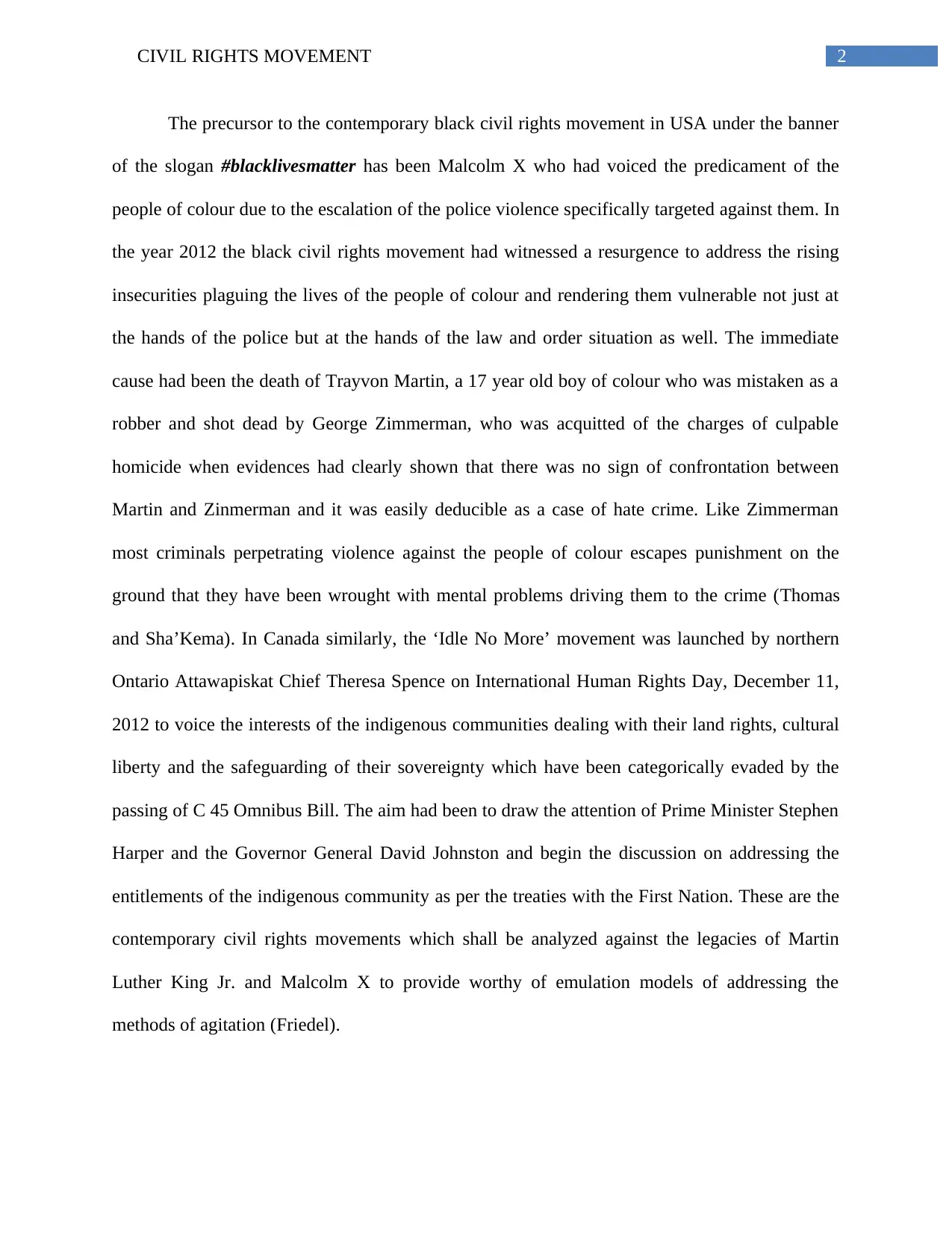
2CIVIL RIGHTS MOVEMENT
The precursor to the contemporary black civil rights movement in USA under the banner
of the slogan #blacklivesmatter has been Malcolm X who had voiced the predicament of the
people of colour due to the escalation of the police violence specifically targeted against them. In
the year 2012 the black civil rights movement had witnessed a resurgence to address the rising
insecurities plaguing the lives of the people of colour and rendering them vulnerable not just at
the hands of the police but at the hands of the law and order situation as well. The immediate
cause had been the death of Trayvon Martin, a 17 year old boy of colour who was mistaken as a
robber and shot dead by George Zimmerman, who was acquitted of the charges of culpable
homicide when evidences had clearly shown that there was no sign of confrontation between
Martin and Zinmerman and it was easily deducible as a case of hate crime. Like Zimmerman
most criminals perpetrating violence against the people of colour escapes punishment on the
ground that they have been wrought with mental problems driving them to the crime (Thomas
and Sha’Kema). In Canada similarly, the ‘Idle No More’ movement was launched by northern
Ontario Attawapiskat Chief Theresa Spence on International Human Rights Day, December 11,
2012 to voice the interests of the indigenous communities dealing with their land rights, cultural
liberty and the safeguarding of their sovereignty which have been categorically evaded by the
passing of C 45 Omnibus Bill. The aim had been to draw the attention of Prime Minister Stephen
Harper and the Governor General David Johnston and begin the discussion on addressing the
entitlements of the indigenous community as per the treaties with the First Nation. These are the
contemporary civil rights movements which shall be analyzed against the legacies of Martin
Luther King Jr. and Malcolm X to provide worthy of emulation models of addressing the
methods of agitation (Friedel).
The precursor to the contemporary black civil rights movement in USA under the banner
of the slogan #blacklivesmatter has been Malcolm X who had voiced the predicament of the
people of colour due to the escalation of the police violence specifically targeted against them. In
the year 2012 the black civil rights movement had witnessed a resurgence to address the rising
insecurities plaguing the lives of the people of colour and rendering them vulnerable not just at
the hands of the police but at the hands of the law and order situation as well. The immediate
cause had been the death of Trayvon Martin, a 17 year old boy of colour who was mistaken as a
robber and shot dead by George Zimmerman, who was acquitted of the charges of culpable
homicide when evidences had clearly shown that there was no sign of confrontation between
Martin and Zinmerman and it was easily deducible as a case of hate crime. Like Zimmerman
most criminals perpetrating violence against the people of colour escapes punishment on the
ground that they have been wrought with mental problems driving them to the crime (Thomas
and Sha’Kema). In Canada similarly, the ‘Idle No More’ movement was launched by northern
Ontario Attawapiskat Chief Theresa Spence on International Human Rights Day, December 11,
2012 to voice the interests of the indigenous communities dealing with their land rights, cultural
liberty and the safeguarding of their sovereignty which have been categorically evaded by the
passing of C 45 Omnibus Bill. The aim had been to draw the attention of Prime Minister Stephen
Harper and the Governor General David Johnston and begin the discussion on addressing the
entitlements of the indigenous community as per the treaties with the First Nation. These are the
contemporary civil rights movements which shall be analyzed against the legacies of Martin
Luther King Jr. and Malcolm X to provide worthy of emulation models of addressing the
methods of agitation (Friedel).
⊘ This is a preview!⊘
Do you want full access?
Subscribe today to unlock all pages.

Trusted by 1+ million students worldwide
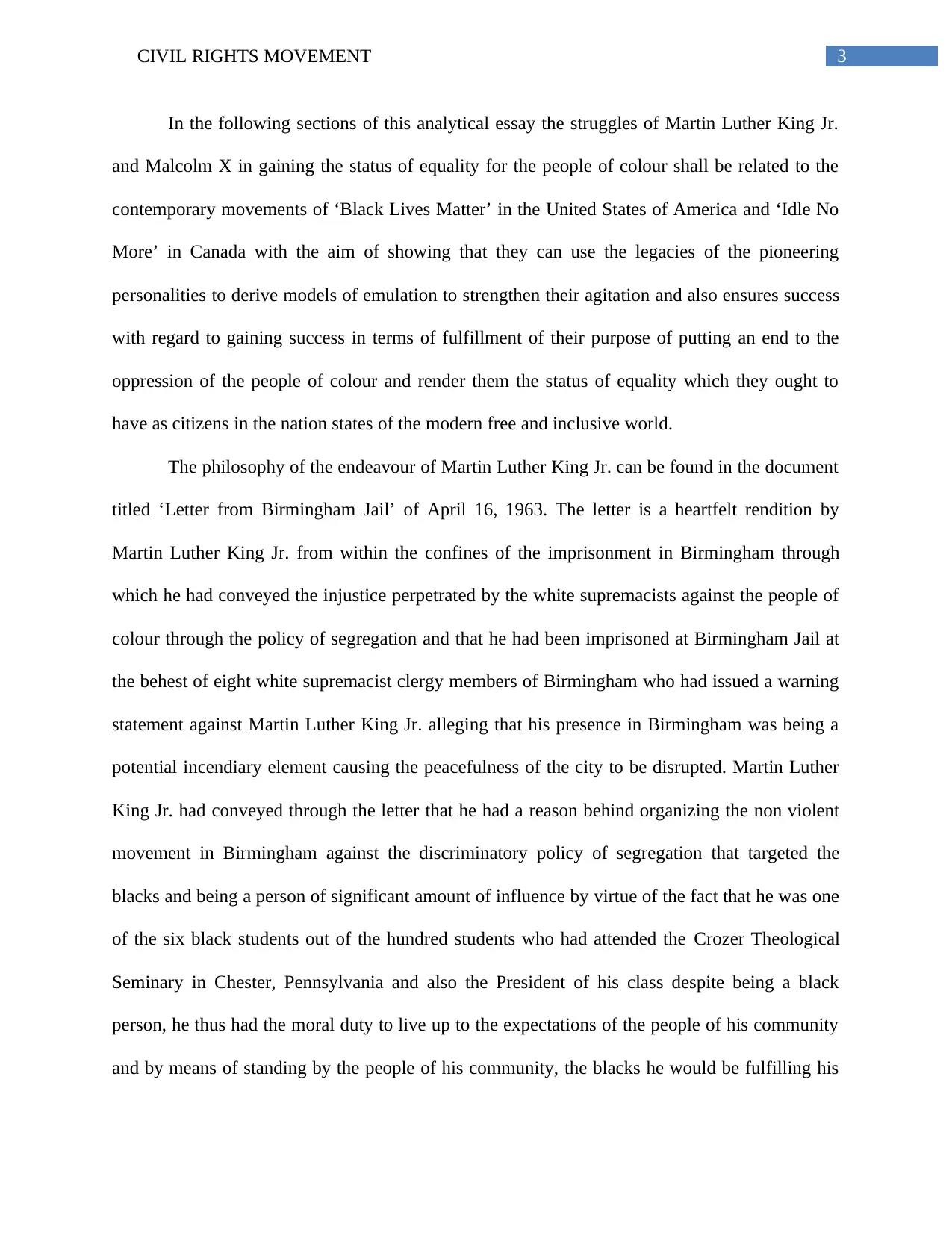
3CIVIL RIGHTS MOVEMENT
In the following sections of this analytical essay the struggles of Martin Luther King Jr.
and Malcolm X in gaining the status of equality for the people of colour shall be related to the
contemporary movements of ‘Black Lives Matter’ in the United States of America and ‘Idle No
More’ in Canada with the aim of showing that they can use the legacies of the pioneering
personalities to derive models of emulation to strengthen their agitation and also ensures success
with regard to gaining success in terms of fulfillment of their purpose of putting an end to the
oppression of the people of colour and render them the status of equality which they ought to
have as citizens in the nation states of the modern free and inclusive world.
The philosophy of the endeavour of Martin Luther King Jr. can be found in the document
titled ‘Letter from Birmingham Jail’ of April 16, 1963. The letter is a heartfelt rendition by
Martin Luther King Jr. from within the confines of the imprisonment in Birmingham through
which he had conveyed the injustice perpetrated by the white supremacists against the people of
colour through the policy of segregation and that he had been imprisoned at Birmingham Jail at
the behest of eight white supremacist clergy members of Birmingham who had issued a warning
statement against Martin Luther King Jr. alleging that his presence in Birmingham was being a
potential incendiary element causing the peacefulness of the city to be disrupted. Martin Luther
King Jr. had conveyed through the letter that he had a reason behind organizing the non violent
movement in Birmingham against the discriminatory policy of segregation that targeted the
blacks and being a person of significant amount of influence by virtue of the fact that he was one
of the six black students out of the hundred students who had attended the Crozer Theological
Seminary in Chester, Pennsylvania and also the President of his class despite being a black
person, he thus had the moral duty to live up to the expectations of the people of his community
and by means of standing by the people of his community, the blacks he would be fulfilling his
In the following sections of this analytical essay the struggles of Martin Luther King Jr.
and Malcolm X in gaining the status of equality for the people of colour shall be related to the
contemporary movements of ‘Black Lives Matter’ in the United States of America and ‘Idle No
More’ in Canada with the aim of showing that they can use the legacies of the pioneering
personalities to derive models of emulation to strengthen their agitation and also ensures success
with regard to gaining success in terms of fulfillment of their purpose of putting an end to the
oppression of the people of colour and render them the status of equality which they ought to
have as citizens in the nation states of the modern free and inclusive world.
The philosophy of the endeavour of Martin Luther King Jr. can be found in the document
titled ‘Letter from Birmingham Jail’ of April 16, 1963. The letter is a heartfelt rendition by
Martin Luther King Jr. from within the confines of the imprisonment in Birmingham through
which he had conveyed the injustice perpetrated by the white supremacists against the people of
colour through the policy of segregation and that he had been imprisoned at Birmingham Jail at
the behest of eight white supremacist clergy members of Birmingham who had issued a warning
statement against Martin Luther King Jr. alleging that his presence in Birmingham was being a
potential incendiary element causing the peacefulness of the city to be disrupted. Martin Luther
King Jr. had conveyed through the letter that he had a reason behind organizing the non violent
movement in Birmingham against the discriminatory policy of segregation that targeted the
blacks and being a person of significant amount of influence by virtue of the fact that he was one
of the six black students out of the hundred students who had attended the Crozer Theological
Seminary in Chester, Pennsylvania and also the President of his class despite being a black
person, he thus had the moral duty to live up to the expectations of the people of his community
and by means of standing by the people of his community, the blacks he would be fulfilling his
Paraphrase This Document
Need a fresh take? Get an instant paraphrase of this document with our AI Paraphraser
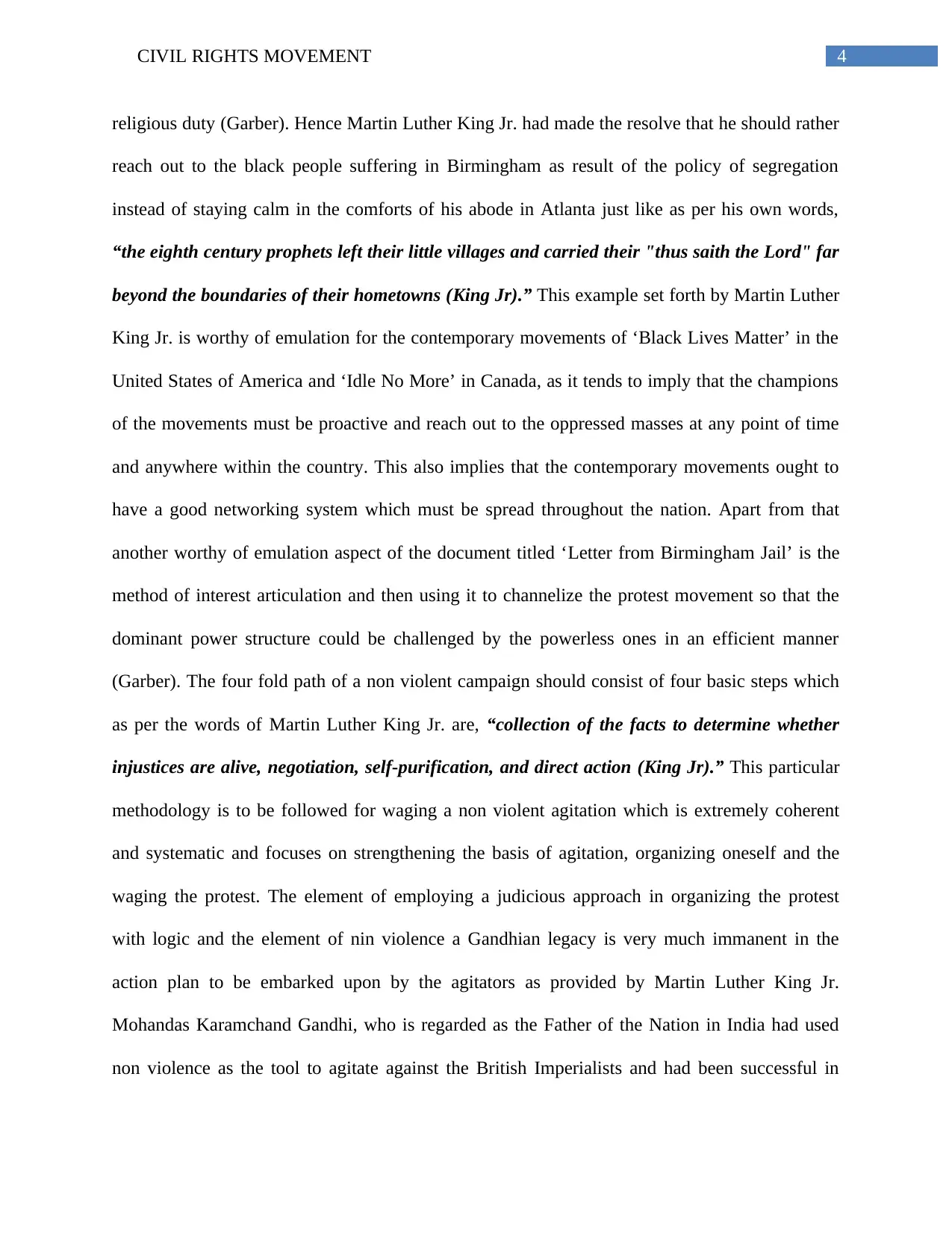
4CIVIL RIGHTS MOVEMENT
religious duty (Garber). Hence Martin Luther King Jr. had made the resolve that he should rather
reach out to the black people suffering in Birmingham as result of the policy of segregation
instead of staying calm in the comforts of his abode in Atlanta just like as per his own words,
“the eighth century prophets left their little villages and carried their "thus saith the Lord" far
beyond the boundaries of their hometowns (King Jr).” This example set forth by Martin Luther
King Jr. is worthy of emulation for the contemporary movements of ‘Black Lives Matter’ in the
United States of America and ‘Idle No More’ in Canada, as it tends to imply that the champions
of the movements must be proactive and reach out to the oppressed masses at any point of time
and anywhere within the country. This also implies that the contemporary movements ought to
have a good networking system which must be spread throughout the nation. Apart from that
another worthy of emulation aspect of the document titled ‘Letter from Birmingham Jail’ is the
method of interest articulation and then using it to channelize the protest movement so that the
dominant power structure could be challenged by the powerless ones in an efficient manner
(Garber). The four fold path of a non violent campaign should consist of four basic steps which
as per the words of Martin Luther King Jr. are, “collection of the facts to determine whether
injustices are alive, negotiation, self-purification, and direct action (King Jr).” This particular
methodology is to be followed for waging a non violent agitation which is extremely coherent
and systematic and focuses on strengthening the basis of agitation, organizing oneself and the
waging the protest. The element of employing a judicious approach in organizing the protest
with logic and the element of nin violence a Gandhian legacy is very much immanent in the
action plan to be embarked upon by the agitators as provided by Martin Luther King Jr.
Mohandas Karamchand Gandhi, who is regarded as the Father of the Nation in India had used
non violence as the tool to agitate against the British Imperialists and had been successful in
religious duty (Garber). Hence Martin Luther King Jr. had made the resolve that he should rather
reach out to the black people suffering in Birmingham as result of the policy of segregation
instead of staying calm in the comforts of his abode in Atlanta just like as per his own words,
“the eighth century prophets left their little villages and carried their "thus saith the Lord" far
beyond the boundaries of their hometowns (King Jr).” This example set forth by Martin Luther
King Jr. is worthy of emulation for the contemporary movements of ‘Black Lives Matter’ in the
United States of America and ‘Idle No More’ in Canada, as it tends to imply that the champions
of the movements must be proactive and reach out to the oppressed masses at any point of time
and anywhere within the country. This also implies that the contemporary movements ought to
have a good networking system which must be spread throughout the nation. Apart from that
another worthy of emulation aspect of the document titled ‘Letter from Birmingham Jail’ is the
method of interest articulation and then using it to channelize the protest movement so that the
dominant power structure could be challenged by the powerless ones in an efficient manner
(Garber). The four fold path of a non violent campaign should consist of four basic steps which
as per the words of Martin Luther King Jr. are, “collection of the facts to determine whether
injustices are alive, negotiation, self-purification, and direct action (King Jr).” This particular
methodology is to be followed for waging a non violent agitation which is extremely coherent
and systematic and focuses on strengthening the basis of agitation, organizing oneself and the
waging the protest. The element of employing a judicious approach in organizing the protest
with logic and the element of nin violence a Gandhian legacy is very much immanent in the
action plan to be embarked upon by the agitators as provided by Martin Luther King Jr.
Mohandas Karamchand Gandhi, who is regarded as the Father of the Nation in India had used
non violence as the tool to agitate against the British Imperialists and had been successful in
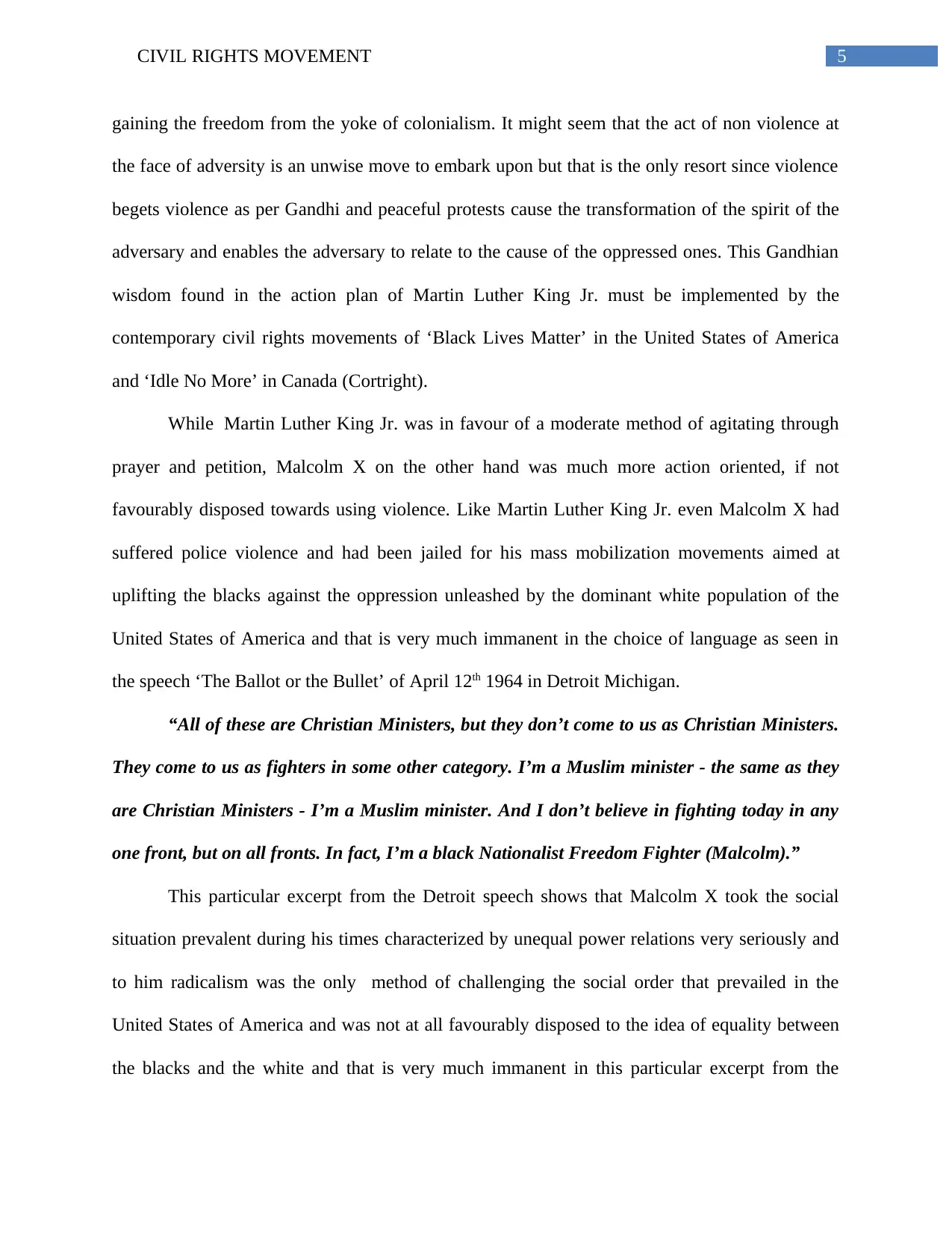
5CIVIL RIGHTS MOVEMENT
gaining the freedom from the yoke of colonialism. It might seem that the act of non violence at
the face of adversity is an unwise move to embark upon but that is the only resort since violence
begets violence as per Gandhi and peaceful protests cause the transformation of the spirit of the
adversary and enables the adversary to relate to the cause of the oppressed ones. This Gandhian
wisdom found in the action plan of Martin Luther King Jr. must be implemented by the
contemporary civil rights movements of ‘Black Lives Matter’ in the United States of America
and ‘Idle No More’ in Canada (Cortright).
While Martin Luther King Jr. was in favour of a moderate method of agitating through
prayer and petition, Malcolm X on the other hand was much more action oriented, if not
favourably disposed towards using violence. Like Martin Luther King Jr. even Malcolm X had
suffered police violence and had been jailed for his mass mobilization movements aimed at
uplifting the blacks against the oppression unleashed by the dominant white population of the
United States of America and that is very much immanent in the choice of language as seen in
the speech ‘The Ballot or the Bullet’ of April 12th 1964 in Detroit Michigan.
“All of these are Christian Ministers, but they don’t come to us as Christian Ministers.
They come to us as fighters in some other category. I’m a Muslim minister - the same as they
are Christian Ministers - I’m a Muslim minister. And I don’t believe in fighting today in any
one front, but on all fronts. In fact, I’m a black Nationalist Freedom Fighter (Malcolm).”
This particular excerpt from the Detroit speech shows that Malcolm X took the social
situation prevalent during his times characterized by unequal power relations very seriously and
to him radicalism was the only method of challenging the social order that prevailed in the
United States of America and was not at all favourably disposed to the idea of equality between
the blacks and the white and that is very much immanent in this particular excerpt from the
gaining the freedom from the yoke of colonialism. It might seem that the act of non violence at
the face of adversity is an unwise move to embark upon but that is the only resort since violence
begets violence as per Gandhi and peaceful protests cause the transformation of the spirit of the
adversary and enables the adversary to relate to the cause of the oppressed ones. This Gandhian
wisdom found in the action plan of Martin Luther King Jr. must be implemented by the
contemporary civil rights movements of ‘Black Lives Matter’ in the United States of America
and ‘Idle No More’ in Canada (Cortright).
While Martin Luther King Jr. was in favour of a moderate method of agitating through
prayer and petition, Malcolm X on the other hand was much more action oriented, if not
favourably disposed towards using violence. Like Martin Luther King Jr. even Malcolm X had
suffered police violence and had been jailed for his mass mobilization movements aimed at
uplifting the blacks against the oppression unleashed by the dominant white population of the
United States of America and that is very much immanent in the choice of language as seen in
the speech ‘The Ballot or the Bullet’ of April 12th 1964 in Detroit Michigan.
“All of these are Christian Ministers, but they don’t come to us as Christian Ministers.
They come to us as fighters in some other category. I’m a Muslim minister - the same as they
are Christian Ministers - I’m a Muslim minister. And I don’t believe in fighting today in any
one front, but on all fronts. In fact, I’m a black Nationalist Freedom Fighter (Malcolm).”
This particular excerpt from the Detroit speech shows that Malcolm X took the social
situation prevalent during his times characterized by unequal power relations very seriously and
to him radicalism was the only method of challenging the social order that prevailed in the
United States of America and was not at all favourably disposed to the idea of equality between
the blacks and the white and that is very much immanent in this particular excerpt from the
⊘ This is a preview!⊘
Do you want full access?
Subscribe today to unlock all pages.

Trusted by 1+ million students worldwide
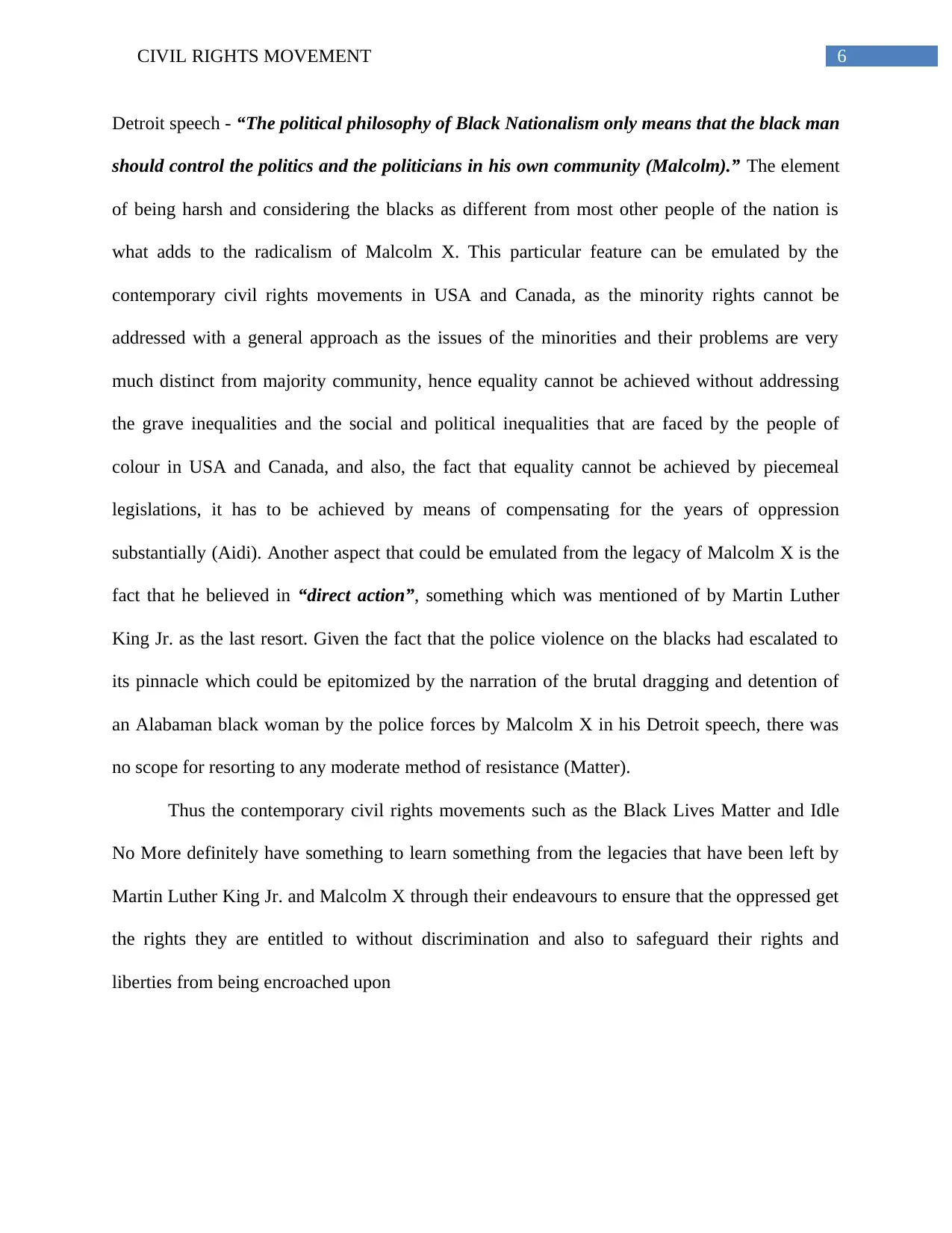
6CIVIL RIGHTS MOVEMENT
Detroit speech - “The political philosophy of Black Nationalism only means that the black man
should control the politics and the politicians in his own community (Malcolm).” The element
of being harsh and considering the blacks as different from most other people of the nation is
what adds to the radicalism of Malcolm X. This particular feature can be emulated by the
contemporary civil rights movements in USA and Canada, as the minority rights cannot be
addressed with a general approach as the issues of the minorities and their problems are very
much distinct from majority community, hence equality cannot be achieved without addressing
the grave inequalities and the social and political inequalities that are faced by the people of
colour in USA and Canada, and also, the fact that equality cannot be achieved by piecemeal
legislations, it has to be achieved by means of compensating for the years of oppression
substantially (Aidi). Another aspect that could be emulated from the legacy of Malcolm X is the
fact that he believed in “direct action”, something which was mentioned of by Martin Luther
King Jr. as the last resort. Given the fact that the police violence on the blacks had escalated to
its pinnacle which could be epitomized by the narration of the brutal dragging and detention of
an Alabaman black woman by the police forces by Malcolm X in his Detroit speech, there was
no scope for resorting to any moderate method of resistance (Matter).
Thus the contemporary civil rights movements such as the Black Lives Matter and Idle
No More definitely have something to learn something from the legacies that have been left by
Martin Luther King Jr. and Malcolm X through their endeavours to ensure that the oppressed get
the rights they are entitled to without discrimination and also to safeguard their rights and
liberties from being encroached upon
Detroit speech - “The political philosophy of Black Nationalism only means that the black man
should control the politics and the politicians in his own community (Malcolm).” The element
of being harsh and considering the blacks as different from most other people of the nation is
what adds to the radicalism of Malcolm X. This particular feature can be emulated by the
contemporary civil rights movements in USA and Canada, as the minority rights cannot be
addressed with a general approach as the issues of the minorities and their problems are very
much distinct from majority community, hence equality cannot be achieved without addressing
the grave inequalities and the social and political inequalities that are faced by the people of
colour in USA and Canada, and also, the fact that equality cannot be achieved by piecemeal
legislations, it has to be achieved by means of compensating for the years of oppression
substantially (Aidi). Another aspect that could be emulated from the legacy of Malcolm X is the
fact that he believed in “direct action”, something which was mentioned of by Martin Luther
King Jr. as the last resort. Given the fact that the police violence on the blacks had escalated to
its pinnacle which could be epitomized by the narration of the brutal dragging and detention of
an Alabaman black woman by the police forces by Malcolm X in his Detroit speech, there was
no scope for resorting to any moderate method of resistance (Matter).
Thus the contemporary civil rights movements such as the Black Lives Matter and Idle
No More definitely have something to learn something from the legacies that have been left by
Martin Luther King Jr. and Malcolm X through their endeavours to ensure that the oppressed get
the rights they are entitled to without discrimination and also to safeguard their rights and
liberties from being encroached upon
Paraphrase This Document
Need a fresh take? Get an instant paraphrase of this document with our AI Paraphraser
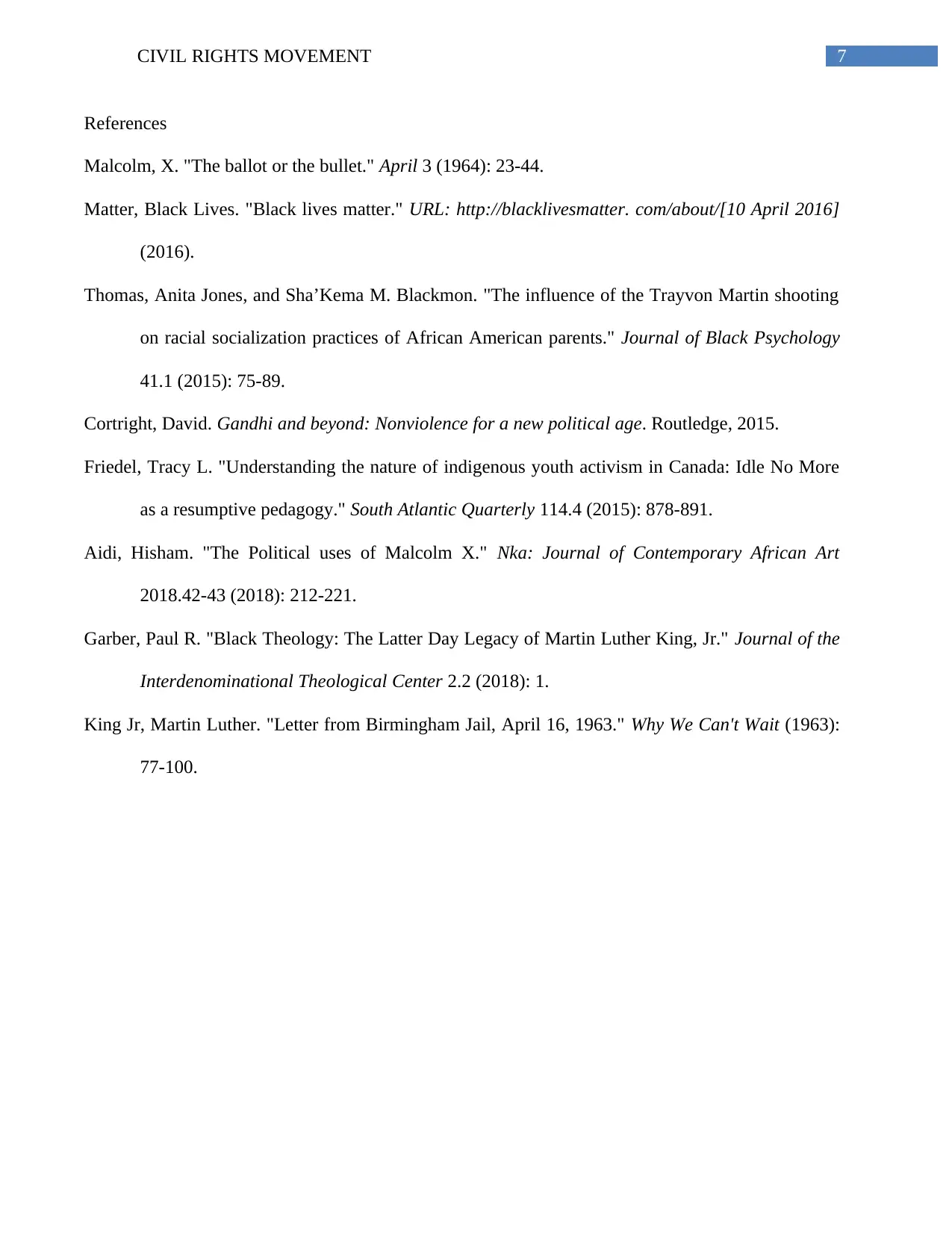
7CIVIL RIGHTS MOVEMENT
References
Malcolm, X. "The ballot or the bullet." April 3 (1964): 23-44.
Matter, Black Lives. "Black lives matter." URL: http://blacklivesmatter. com/about/[10 April 2016]
(2016).
Thomas, Anita Jones, and Sha’Kema M. Blackmon. "The influence of the Trayvon Martin shooting
on racial socialization practices of African American parents." Journal of Black Psychology
41.1 (2015): 75-89.
Cortright, David. Gandhi and beyond: Nonviolence for a new political age. Routledge, 2015.
Friedel, Tracy L. "Understanding the nature of indigenous youth activism in Canada: Idle No More
as a resumptive pedagogy." South Atlantic Quarterly 114.4 (2015): 878-891.
Aidi, Hisham. "The Political uses of Malcolm X." Nka: Journal of Contemporary African Art
2018.42-43 (2018): 212-221.
Garber, Paul R. "Black Theology: The Latter Day Legacy of Martin Luther King, Jr." Journal of the
Interdenominational Theological Center 2.2 (2018): 1.
King Jr, Martin Luther. "Letter from Birmingham Jail, April 16, 1963." Why We Can't Wait (1963):
77-100.
References
Malcolm, X. "The ballot or the bullet." April 3 (1964): 23-44.
Matter, Black Lives. "Black lives matter." URL: http://blacklivesmatter. com/about/[10 April 2016]
(2016).
Thomas, Anita Jones, and Sha’Kema M. Blackmon. "The influence of the Trayvon Martin shooting
on racial socialization practices of African American parents." Journal of Black Psychology
41.1 (2015): 75-89.
Cortright, David. Gandhi and beyond: Nonviolence for a new political age. Routledge, 2015.
Friedel, Tracy L. "Understanding the nature of indigenous youth activism in Canada: Idle No More
as a resumptive pedagogy." South Atlantic Quarterly 114.4 (2015): 878-891.
Aidi, Hisham. "The Political uses of Malcolm X." Nka: Journal of Contemporary African Art
2018.42-43 (2018): 212-221.
Garber, Paul R. "Black Theology: The Latter Day Legacy of Martin Luther King, Jr." Journal of the
Interdenominational Theological Center 2.2 (2018): 1.
King Jr, Martin Luther. "Letter from Birmingham Jail, April 16, 1963." Why We Can't Wait (1963):
77-100.
1 out of 8
Related Documents
Your All-in-One AI-Powered Toolkit for Academic Success.
+13062052269
info@desklib.com
Available 24*7 on WhatsApp / Email
![[object Object]](/_next/static/media/star-bottom.7253800d.svg)
Unlock your academic potential
Copyright © 2020–2025 A2Z Services. All Rights Reserved. Developed and managed by ZUCOL.





